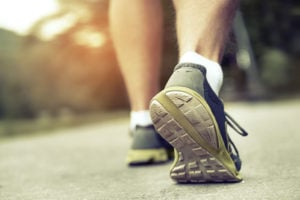Are you one of the millions of Americans suffering with osteoarthritis? Studies show that gait training – learning to walk differently – is one way to ease your knee pain.
Osteoarthritis: quick facts
One of the primary reasons that patients seek knee pain relief is because of degenerative joint disease, also known as osteoarthritis (OA). OA is a disease of the joints that primarily impacts the cartilage. Cartilage is a critical building block of the human body, notes Dr Ananya Mandal, MD. The connective tissue is densely packed but not as rigid as bone. When the cartilage is healthy, the bones can move smoothly against one another. Plus, it serves as a shock absorber.
During osteoarthritis, the top layer of cartilage starts to deteriorate, which results in direct bone-to-bone contact. The movement of the bones against one another results in reduced range of motion, inflammation, and pain. The joint can actually start to change shape, and bone spurs sometimes appear. Finally, small pieces of cartilage or bone may separate from their natural positions and move freely within the joint space, resulting in additional pain and swelling.
“People with osteoarthritis often have joint pain and reduced motion,” explains the National Institute of Arthritis and Musculoskeletal and Skin Diseases.
Changing how you walk for osteoarthritis relief
 Removing some of the force from the joint will help to slow the progression of this disease, says Shanghai Jiao Tong University mechanical engineering professor, Pete Shull, PhD. Typically when you suffer from OA, the inside of the joint is the area that is lowest on cartilage. You can distribute the pressure to the outside with a revised walking style.
Removing some of the force from the joint will help to slow the progression of this disease, says Shanghai Jiao Tong University mechanical engineering professor, Pete Shull, PhD. Typically when you suffer from OA, the inside of the joint is the area that is lowest on cartilage. You can distribute the pressure to the outside with a revised walking style.
The best approach is to angle your toes just a little bit inward, according to Shull’s 2013 study, published in the Journal of Orthopaedic Research. The research team had ten osteoarthritis patients walk with their toes pointed 7 degrees toward one another for a month and a half. Once every week, the patients would return for further training on the walking style – walking on treadmills, with gauges that would vibrate when their gait wasn’t directed with the toes to the inside. The study participants walked with their toes inward in their daily lives as well.
“[M]ost of them were comfortably walking with the new gait within a month,” says Everyday Health. “Participants reported that pain and function improved by about 30 percent a month after training.”
The impressive results from this study suggest that gait training could help to ease your knee pain.
Knee pain relief
Gait training is actually just one way to alleviate chronic knee pain. The Knee-Flex 5-Step Protocol takes the very latest FDA-approved, non-surgical knee pain treatment, and enhances it to provide a level of results that few others can match. Learn more.






